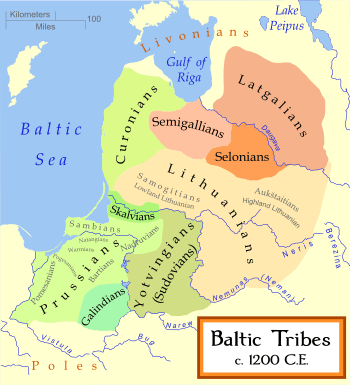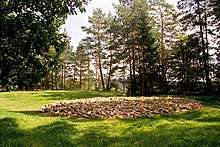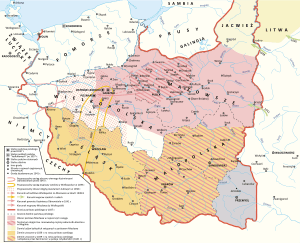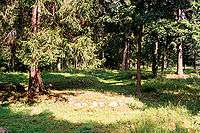Yotvingians
Yotvingians, or Sudovians (also called Suduvians, Jatvians, or Jatvingians in English; Lithuanian: Jotvingiai, Sūduviai; Latvian: Jātvingi; Polish: Jaćwingowie, Belarusian: Яцвягі, German: Sudauer), were a Baltic people with close cultural ties in the 13th century to the Lithuanians and Prussians. The Yotvingian language (sometimes called Sudovian) was a Western Baltic language, nearest to Old Prussian but with small variations. They were referred to in regional historical records into the 19th century.[1]



Geography
The Yotvingian lived in the area of Sudovia (Yotvingia) and Dainava, southwest from the upper Neman (Nemunas). Today this area corresponds mostly to the Podlaskie Voivodeship of Poland, portions of Lithuania and a part of Hrodna Province of Belarus. The territory was between later the Marijampolė and Merkinė (Lithuania); Slonim and Kobryn (Belarus); and Białystok, and Lyck,in Prussia now Ełk (Poland).
Vytautas the Great wrote about "terra Sudorum", in a letter to King Sigismund of March 11, 1420.
Name
The name Sūduva, according to Vytautas Mažiulis ("Prūsų kalbos etimologijos žodynas", Etymological Dictionary of the Prussian Language), derives from a local hydronym *Sūd(a)vā, in turn derived from a Baltic verbal root *sū-: to flow, pour.[2]
A. S. Kibin proposed Yotvingian, or the "Slavic Jatviagi as the group name goes back to O. N. patronymic derivative játvingar meaning « the descendants of Játvígr », or « the people of Játvígr »" - "the name Játvígr mentioned by Knytlinga saga".[3] J. Pashka, acknowledging Kibin's proposal, has similarly interpreted the ethnonym as derived from the Old Norse Játvígr, with a genitive Játvígs liðsmenn ( ᛃᚨᛏᚢᛁᚴᛋ ᚱᛟᚦᛋ ) label of Játvígr's Viking expedition and his Norse Rus' settlers ( i.e. Indura, Belarus ) by the Nemunas river. Pashka asserts the nasal infixation in the original Old Norse Játvíg name of the 944-945 Kiev Treaty was probably an insignificant scribal error or misinterpretation, that has survived to the present.[4]
History
According to The Histories of Herodotus (5th century B.C.), the Neuri Νευροί were a tribe living beyond the Scythian cultivators, one of the nations along the course of the river Hypanis (Bug river), west of the Borysthenes (Dniepr river). This was roughly the area of modern Belarus and Eastern Poland by the Narew river, coinciding with the Yotvingian linguistic territory of toponyms and hydronyms (Narew river).
In 944, during the treaty between the Kievan Rus' prince Igor and the emperor of the Byzantine Empire, the Yotvingians were hired by the Kievan ruler to serve as mercenaries. Also Vladimir I of Kiev, in 983, hired the Yotvingians to add to his army.[5]
Ptolemy in the 2nd century AD called the people Galindai kai Soudinoi (Σουδινοί). Peter von Dusburg called them Galindite and Suduwite. In the Hypatian Codex the spellings are changing: Jatviagy, Jatviezie, Jatviažin, zemlia Jatveskaja, na zemliu Jatviažs´kuju and more. Polish sources also used Russian spellings: Jazviagi, Iazvizite, Jazvizite, Yazvizite. In the treaty with the Teutonic Knights in 1260, the region is called "terre Getuizintarum". This name was taken by the papal administration: terra Jatwesouie, Gretuesia, Gzestuesie, Getuesia und Getvesia. The Knights called this tribe Sudowite, Sudowia, in qua Sudowit.
In the sentence of Breslau of the emperor Sigismund of Luxembourg to the Order of Livland from 1325, this area is called Suderlandt alias Jetuen. In two dotations (1253 and 1259) of Mindaugas I, a new name was recorded: Dainava, Deynowe, Dainowe, Denowe (land of songs). The forests were named Deinova Jatvež.
Yotvingians also had a strong warrior culture and were generally well known as great warriors and hunters, and were feared by their neighbours for their skill in warfare. Skalmantas, leader of the Yotvingians was responsible for single-handedly raiding Pinsk in the Principality of Turov.
A census by the clergy of the Belarus Grodno area in 1860 had as many as 30,929 inhabitants identifying as Yatviags.[1]
Historical persons
- Skalmantas, leader of Sudovians, took part in the Prussian uprisings.[6]
See also
Literature
- Marija Gimbutas, The Balts. London : Thames and Hudson, Ancient peoples and places 33, 1963.
- Totoraitis, J., Sūduvos Suvalkijos istorija. Marijampolė: Piko valanda.(2003) [1938] ISBN 978-9986-875-87-1.
- Witczak, K. T., Traces of Dual Forms in Old Prussian and Jatvingian in Woljciech Smoczynski and Axel Holvoet, eds, Colloquium Pruthenicum primum, 1992, pp 93–98
- Gerullis, G., Zur Sprache der Sudauer-Jadwinger, in Festschrift A. Bezzenberger, Göttingen 1927
- Toporov,V., ИНДОЕВРОПЕЙСКЕ ЯЗЫКИ [Indo-European languages] Лингвистический энциклопеический словарь.[Linguistic encyclopedic dictionary] Moskva, 1990, pp 186–189
- Mažiulis, V., Baltic languages. Britannica Online Encyclopedia
- Henning, E., De rebus Jazygum sive Jazuin-gorum, Regiomonti, 1812
- Sjoegren, A., Ueber die Wohnsitz Verhaeltnisse und der Jatwaeger, St. Petersburg, 1859
- Sembrzycki, J., Die Nord-und Westgebiete the Jadwinger und deren Grenzen, Altpreussischeme Monatschrift, XXVIII, 1891, pp. 76–89
- W. R. Schmalstieg, Studies in Old Prussian, University Park and London, 1976.
- V. Toporov, Prusskij jazyk: Slovar', A - L, Moskva, 1975-1990.
- V. Mažiulis, Prūsų kalbos etimologijos žodynas, Vilnius, t. I-IV, 1988-1997.
- Archäologie der UDSSR: Die Finno-Ugrier und die Balten im Mittelalter, Teil II, Balten, S. 411-419, Moskau 1987
- Lepa, Gerhard (Hrsg): Die Sudauer, in Tolkemita-Texte Nr. 55, Dieburg 1998
- Lepa, Gerhard: Gedanken über die Prußen und ihre Lieder, in Tolkemita-Texte „25 Lieder der Sudauer“ Nr. 56, Dieburg 1999
- Litauische Enzyklopädie, Bd. XXVX, Boston, USA, 1963
- Salemke, Gerhard: Lagepläne der Wallburganlagen von der ehemaligen Provinz Ostpreußen, Gütersloh, 2005, Karten 19/ 7 - 19/ 13
- Žilevičius, Juozas: Grundzüge der kleinlitauischen Volksmusik, in Tolkemita-Texte „25 Lieder der Sudauer“ Nr. 56, Dieburg 1999
References
- Sabaliauskas, A., Mes Baltai / We, the Balts (1995), Vilnius, Lithuania: Science and Encyclopedia Publishers, p 80
- Mažiulis, V., Prūsų kalbos etimologijos žodynas, t. IV, (1997) Vilnius, pp 166–167, ISBN 978-5-420-01406-6.
- Кибинь A.С. Ятвяги в X-XI вв.: «балтское племя» или «береговое братство»? // Studia Slavica et Balcanica Petropolitana. 2008. № 2(4). С.117-132
- Pashka, Joseph, Virdainas © 1994, 2nd Edition, USA
- https://www.ancient-origins.net/history/yotvingians-mighty-warriors-baltic-sea-005772
- Simas Sužiedėlis, ed (1970–1978). "Skomantas". Encyclopedia Lituanica. V. Boston, Massachusetts: Juozas Kapočius. pp. 210. LCC 74-114275.
- Gimbutas, Marija, The Balts, (1963) London : Thames and Hudson, pp 97–102.
- Mažiulis, V, Prūsų kalbos etimologijos žodynas,t. II, (1993) Vilnius: Mokslas, pp 7–12, ISBN 978-5-420-00791-4.
- ANTONIEWICZ, J., The mysterious Sudovian people, Archaeology, II, 3, 1958
- ANTONIEWICZ, J., The Sudovians, Białystok, 1962.
- DUSBURG (PETRI DE DUSBURG), Chronicon Prussiae, ed. Chr. Hartknock, Jena, 1879
External links
| Wikimedia Commons has media related to Yotvingia. |
